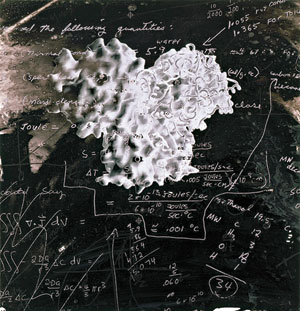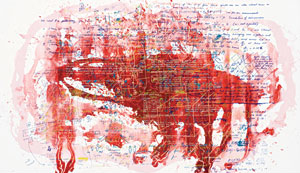
Watching the Wheels
Inside artist Steve Miller’s fragile universe
Author: Drew Moss | Published: Friday, August 23, 2013

Sagaponack artist Steve Miller’s mind is focused on the fundamentals, but his work is wildly abstract and rife with imagination. Miller’s unique combination of hypermodern abstract expressionism and traditional scientific empiricism opens a portal not only into his creative realm, but also into the essential building blocks of the universe.
 Blackboard Jungle, 2005
Blackboard Jungle, 2005
Miller’s art has taken him all over the world, but his most recent work goes beyond the beyond as it takes on the massive issues of global warming and environmental awareness. His Health of the Planet series starts out as a collection of X-ray images of Brazilian plant life.
Miller then manipulates those images by adding small touches of random Pollock-esque splatter to them, lending levity and creativity to their clinical representation of our inner world. The results are imaginative portraits of the engine that drives our living, breathing planet. When they sway in the breeze or shudder in the rain, our flora and fauna are doing the cosmic dance. And Miller is committed to capturing that inner energy, the strength and fragility of the hidden life that connects us all.
“The idea for Health of the Planet came to me when I was first visiting Brazil in 2005,” Miller said. “I was on an island called Ilha Grande where I experienced the Atlantic rainforest for the first time. I’ve never seen anything so abundantly green with fruits hanging from trees of an enormous size. The amateur scientist in me made me wonder what was inside these enormous fruits called jaca. I wanted to take them to a hospital to make an X-ray… If the forests of Brazil are the lungs of our planet, I would give Brazil a medical checkup by taking X-rays of these lungs. The science aspect of looking at these plants, animals and the earth lets us use a new lens under which we can study the patient Planet Earth. This lens reveals a fragile beauty in crisis.”
This environmentally conscious milieu, whether by design or fortune, has led Miller to the elusive crossover from art to commerce. His works are being featured in a line created by Osklen, a Brazil-based sportswear and clothing company with an environmentally conscious mission. “I love the collaboration with Osklen in Brazil because it lets you actually wear the message,” Miller said. “You don’t have to be a collector to afford my art. I’m using both art and fashion as a vehicle to disseminate the message about the urgency of our worldly situation. We’re in this fragile and delicate coalition with the notion of sustainability.”
 Booming Demand, 2013
Booming Demand, 2013
One of the more compelling techniques that Miller employs to convey his message evokes the provocative graffiti of Jean-Michel Basquiat and even the “strategic signage” of French New Wave guru Jean Luc Godard. In many of his works, Miller uses the scribble of mathematical and scientific equations as both intellectual accent and whimsical distraction. As the mad chalkboard ramblings of scientists and mathematicians find their way into his panels, they form an ephemeral pastiche of scientific machination at work. The result gives us pause, gives us a chance to reflect on the big wheels at work and allows us to appreciate the efforts of those who attempt to understand those complex cogs.
“The language of science is mathematics,” Miller said. “The hand scribble of the scientific equation looks a lot like graffiti… Both graffiti and mathematical equations can appear to be abstract, incomprehensible and deeply human… Yet, I think everyone can appreciate the mystery and the beauty of the scientific scribbles. We can admire the scientific achievements achieved by the human mind as well as by artists… These tiny particles, which are described by the mathematical equations, are the subatomic units that connect all of us. If art can bring ideas together in the way particles can attract each other, then the notion of connecting to each other is [an] important one. It’s physically natural for particles to embrace and attract each other and the same principles apply to humans. I’m dreaming that my art can be a part of this process.”
Steve Miller’s work will be featured by the Robin Rice Gallery in lower Manhattan through September 15th. His clothing line is available at Osklen’s SoHo store.
